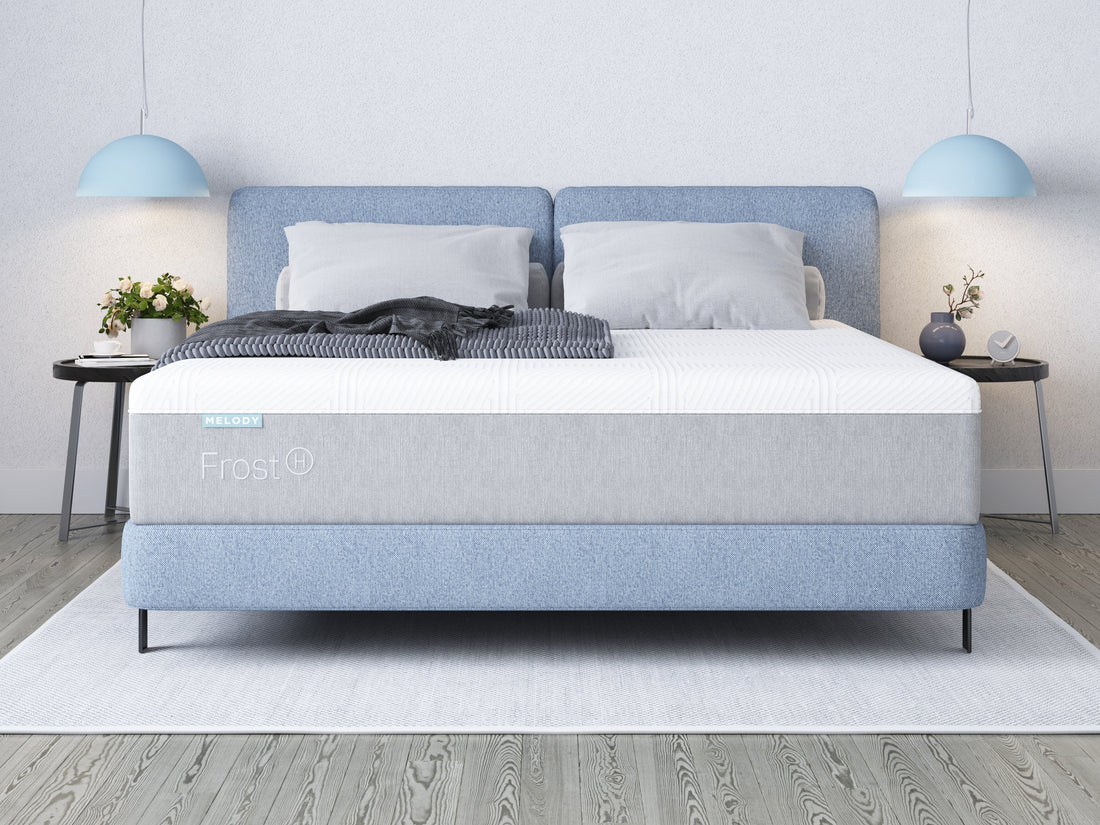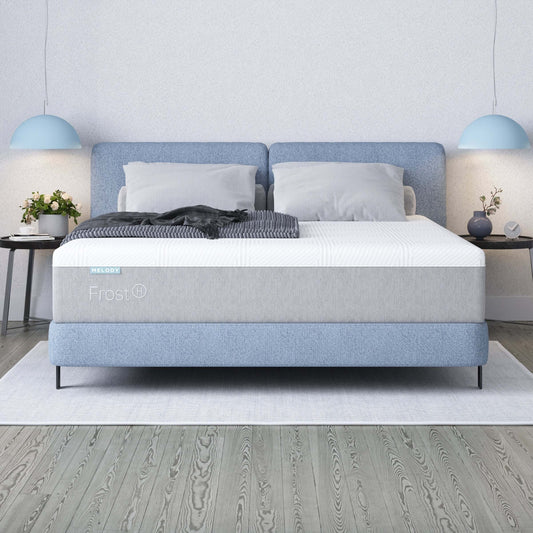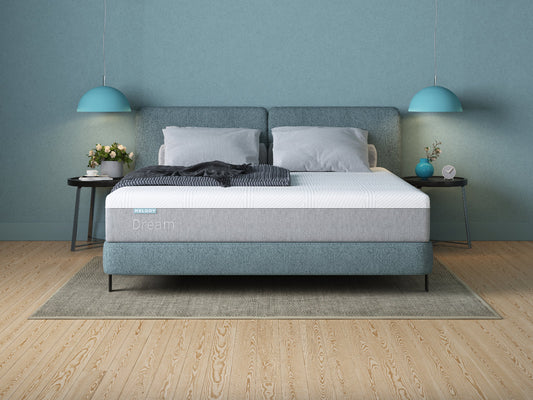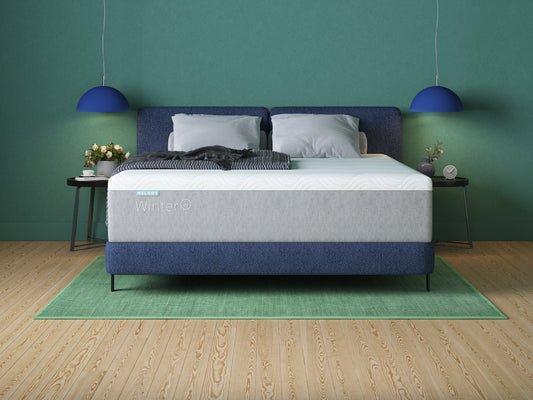If you’ve ever wondered why you’re waking up more tired than when you went to bed, your mattress might need a replacement. Keep in mind that they don’t last forever, and using one past its prime can seriously affect your sleep quality and even your health.
So, how often should you replace your mattress?
On average, most mattresses last 7 to 10 years, but that range can vary depending on the particular product, how well it’s maintained, and how your body affects it over time.
In this guide, we’ll break down how long different types typically last, what signs to look for when yours is due for a replacement, and how to get the most years (and comfort) out of your investment.
Let’s help you sleep smarter — and better.
Key Takeaways
- Most mattresses last between 7–10 years, but their exact lifespan depends on the type and quality.
- Foam, innerspring, and hybrid models each have different durability profiles.
- Signs it’s time to replace your mattress include sagging, discomfort, increased allergies, and noisy springs.
- Proper care (like rotating, cleaning, and using a protector) can significantly extend your mattress's lifespan.
- Your weight, sleeping habits, and bed frame all influence how long a mattress will perform well.
- Replacing your mattress at the right time can lead to better sleep, improved health, and fewer aches and pains.
How Long Different Mattress Types Last
Not all mattresses are created equal, and the type you sleep on plays a big role in how long it will last before needing a replacement.
Here's a closer look at the average lifespan of a few common mattress types:
Innerspring Mattresses (6–8 years)
Innerspring mattresses use a coil support system and tend to have a shorter lifespan than other types, usually around 6 to 8 years. While they offer good initial support and bounce, the coils can lose tension, and the padding may compress with regular use.
If you’re noticing squeaks, sagging spots, or a lack of support, your innerspring might be nearing the end of its life
Foam Mattresses (7–9 years)
Foam mattresses (especially those made with memory foam) are known for their contouring support and pressure relief. On average, a quality foam mattress lasts between 7 and 9 years.
However, cheaper foams tend to break down faster, leading to sagging or body impressions over time. Dense, high-quality foams usually hold up longer, especially if you rotate the mattress regularly and use a proper base.
Hybrid Mattresses (8–10 years)
Hybrid mattresses combine the best of both worlds — the support of innerspring coils and the comfort of foam or latex layers. Thanks to their more durable construction, they generally last 8 to 10 years.
That said, the lifespan of a hybrid mattress depends on the quality of its materials and how well you care for it. A well-built product can outlast a basic innerspring, especially with proper maintenance.
🛏️ Order a High-Quality Hybrid Mattress Now

Mattress Type Comparison Table
Signs It's Time to Replace Your Mattress
Over time, even the best mattress loses its ability to support your body and maintain comfort. If you’re noticing any of the following signs, it might be time to start shopping for a replacement:
1. You Wake Up Sore or Stiff
If you regularly wake up with aches, stiffness, or general discomfort, your mattress may no longer provide the support your body needs.
As it ages, it can lose its ability to align your spine properly, leading to poor sleep, waking up with neck pain, and other issues.
2. You See Visible Wear and Tear
Obvious signs like sagging, deep body impressions, lumps, or frayed edges are clear indicators that your mattress has seen better days.
These issues are not only associated with aesthetics but can also affect comfort and interfere with your body’s ability to rest in a healthy position.
3. Your Mattress Makes Noise
Are you hearing creaks, squeaks, or groans when you move? That could signal worn-out springs or weakened internal components.
These noises can be distracting at night and are often a sign that your mattress is nearing the end of its life.
4. You’re Experiencing Allergy Flare-Ups
Old mattresses can accumulate dust mites, pet dander, mould, and other allergens over time, even with regular cleaning. If you wake up with a stuffy nose, sneezing, or itchy eyes more often, this could be the hidden cause.
Replacing it with a newer, hypoallergenic model can make a big difference in your sleep and health.
🛡️ Buy a Melody Sleep Mattress Built from Allergen-Resistant Materials
How Mattress Maintenance Affects Its Lifespan
With just a bit of regular maintenance, you can extend your mattress’s life by several years while also keeping it more comfortable and hygienic.
Here’s how to get the most out of your mattress:
1. Rotate or Flip (When Applicable)
Rotating your mattress every 3 to 6 months can help prevent uneven wear and deep body impressions, especially for foam and hybrid models. Some older innerspring mattresses and double-sided designs can also be flipped.
However, always check your manufacturer’s guidelines first — many modern products are designed to be one-sided and should not be flipped.
2. Clean It Regularly
Dust, dead skin, sweat, and even allergens can build up over time. Vacuuming your mattress surface every few months and spot-cleaning any stains can help preserve the integrity of the materials and create a healthier sleep environment.
Also, allowing it to air out occasionally can also reduce moisture buildup that leads to mould or mildew, especially in humid climates like Singapore.

3. Use a Mattress Protector
A high-quality, breathable protector is one of the simplest and most effective ways to prolong your mattress’s life. It acts as a barrier against spills, sweat, dust mites, and allergens.
Plus, it’s much easier to wash a protector than to deep-clean an entire mattress. Look for protectors that are waterproof yet breathable to maintain comfort and airflow.
4. Support It with a Proper Base
Your mattress needs a sturdy, supportive foundation — whether that’s a box spring, platform bed, or adjustable base.
An uneven or sagging frame can lead to premature sagging in your mattress and even void your warranty.
🛏️ Order a Durable Bed Frame for Your Mattress
How Weight Distribution Impacts Mattress Lifespan
Something many people overlook when shopping for or maintaining a mattress is how weight distribution affects its longevity.
The truth is, the more pressure it consistently bears (especially in concentrated areas), the faster it can wear out.
1. Heavier Body Weight
Mattresses will naturally compress over time, but heavier sleepers tend to experience this sooner.
If you're sharing your bed or if you're on the heavier side, consider a model specifically designed for higher weight capacity, such as a hybrid with reinforced coils.
2. Sleeping Position
Your preferred sleeping position also plays a role. Side sleepers, for example, concentrate pressure on the shoulders and hips, which can create indentations over time.
Back and stomach sleepers tend to spread weight more evenly, putting less stress on any single part of the mattress.
3. Shared Sleepers and Motion Zones
When two people sleep on the same mattress, it’s common to see more wear on the side that bears more weight. Some couples even develop a “ridge” in the middle where neither person sleeps.
To avoid this, rotate your mattress regularly and consider one with zoned support or dual firmness levels designed to accommodate different body types.

💡 Get a Well-Designed Mattress Today
How Long Does a Mattress Last? - Final Thoughts
Your mattress plays a bigger role in your well-being than you might think. From physical support to sleep quality and even allergy control, the condition of your bed directly affects how you feel each day.
Most mattresses last between 7 and 10 years, and to increase the chances it will serve you somewhat longer than shorter, give it the proper care and stay aware of the wear and tear signs. Choosing a product from durable materials and designed for proper weight distribution in the first place can also make a significant difference.
If your sleep hasn’t been the same lately, it might be more than just stress or routine. It could be your mattress telling you it’s time to replace it.
Ready for an Upgrade?
A high-quality mattress is one of the best investments you can make for your health, energy, and comfort.
Frequently Asked Questions
1. How often should I replace my mattress?
Most mattresses should be replaced every 7 to 10 years, but that can vary based on the type, how much wear it gets, and how well it’s maintained.
If you notice signs like sagging, discomfort, or sleep disruptions (even before that time frame), it’s likely time for a replacement. Always listen to how your body feels in the morning, as that’s often your best indicator.
2. Does the bed frame or foundation affect how long a mattress lasts?
Absolutely. A weak or unsupportive foundation can cause it to sag prematurely.
Always make sure your bed frame provides even, solid support, especially for foam and hybrid models that require more stability than innerspring beds.
3. Is it worth getting a topper to extend the lifespan of an old mattress?
A dedicated topper can offer temporary comfort and pressure relief, especially if your mattress is just starting to feel worn. But it won’t fix underlying support issues.
If you can feel it is sagging or causing pain, a topper may just mask the problem instead of solving it.
4. How do I know if my mattress is causing my allergies?
If you notice symptoms like sneezing, congestion, or itchy eyes that improve when you're away from home, your mattress could be harboring dust mites or allergens.
Using a hypoallergenic protector and vacuuming regularly can help, but if symptoms persist, it may be time to replace the mattress.
5. What mattress types are best for hot sleepers who want long-lasting comfort?
Hot sleepers should look for mattresses with advanced cooling technologies, like hybrids with breathable coils or gel-infused memory foam, as they offer better airflow and temperature regulation.
As the lifespan of a hybrid mattress is typically long, they are a smart investment that will serve you (and cool you) for many years to come.




